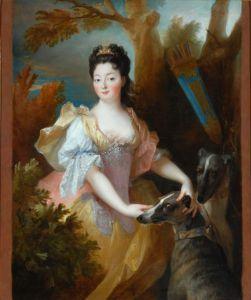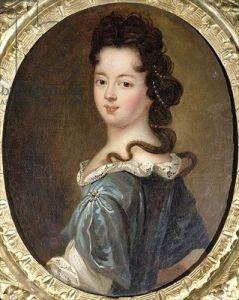While I am your mistress, I will treat you like a king. But once we part ways, I care not where you may go. – Bérénice, Madame de Pascal
 It may be that Bérénice was only a stage name, but there’s no way to be sure because it’s the only one any record discovered to date ever uses for her. She was born in a village near Naples somewhere around 1640, and though she always claimed her father had run off soon after she was born, it is entirely possible that her mother, a waitress and casual prostitute, actually had no idea of his identity. Like so many courtesans she was noted for her precociousness, married too early, created an exotic stage persona which won her the attentions of wealthy men and died far too young, but unlike many she died in a high station and very wealthy, having amassed a personal fortune equivalent to about $360 million in 2016 dollars.
It may be that Bérénice was only a stage name, but there’s no way to be sure because it’s the only one any record discovered to date ever uses for her. She was born in a village near Naples somewhere around 1640, and though she always claimed her father had run off soon after she was born, it is entirely possible that her mother, a waitress and casual prostitute, actually had no idea of his identity. Like so many courtesans she was noted for her precociousness, married too early, created an exotic stage persona which won her the attentions of wealthy men and died far too young, but unlike many she died in a high station and very wealthy, having amassed a personal fortune equivalent to about $360 million in 2016 dollars.
Bérénice’s mother appears to have been as bereft of parental instinct as her unknown father, and vanished from her daughter’s life before her 9th birthday. She left the child in the keeping of her own mother, a rather dour old woman said to have been of Moorish descent. In the 17th century, Italy was not as hospitable to courtesans as it had been a century before, but young Bérénice’s exceptional looks would have attracted attention even in a time of far more repressive sexual morality; by the time she was 13 her grandmother had married her off to the relatively-wealthy Lorenzo Gordini, a man some four times her age. And there her story might have ended had her husband not died some four years later of an unnamed disease, probably some kind of cancer, leaving her the heir to a modest fortune; unfortunately, Gordini had three adult children from a previous marriage who contested the will, and Bérénice was forced to sign most of it over to them to avoid a long and protracted court battle. Even so, she was left with far greater resources than the average 17-year-old in any century, and so made a decision perhaps not out of character for a fairly-well-off teenager with nobody to answer to: she moved to Paris.
Bérénice arrived in Paris late in the summer of 1658, and though she had neither experience nor reputation as a courtesan her stunning looks and quick wit soon attracted the attention of Alexandre de Crécy, one of Cardinal Mazarin’s important lieutenants; she became his mistress and accompanied him on his various missions for the Cardinal to various parts of France and other nearby countries. While de Crécy certainly enjoyed her company, he had an ulterior motive for taking her everywhere with him: he was insanely jealous and wanted her where he could keep an eye on her. Bérénice soon tired of his controlling behavior, and since she had means of her own was not highly motivated to endure it; while he was en route to Spain in 1660, she abandoned him and fled back to Paris, where she traded on her well-known connection to de Crécy to install herself into the social scene. Not that she needed much help; she was petite, charming and very beautiful (with black eyes, lustrous black hair and an 18-inch waist), and her first husband had bequeathed her something far more valuable than money: an education. She soon began to prosper as a courtesan, catering to the elite of Louis XIV’s court, and by 1664 had saved enough money to purchase a large, tasteful maison of her own, to which she always retreated when she wanted solitude; she only rarely entertained there.
 Though Bérénice’s charms were many, it was her skill as a storyteller which set her apart and won her a devoted following; she embroidered upon her own background and life experiences so heavily that, with the exception of details that can be fixed by records such as her first husband’s will, it is impossible to know which are real. Many of the details of her early life (that lovers had fought duels over her, that she had traveled from Naples to Paris alone on horseback, that she had shot a man who attempted to violate her) recorded by biographers sound more like tall tales than probable events, and even her dramatic escape from de Crécy (perhaps even his jealousy) may have been exaggerated for effect. One thing is certain: it was in 1666 that she attracted her first VIP client, Jean-Baptiste Colbert, the Minister of Finance. He was the perfect client for Bérénice; though he was very generous with her he prized discretion above all else, and never interfered with her social life. He saw her regularly, probably several times a month, until 1676, and though he had apparently grown tired of her by that time he ensured her future by not only securing her an allowance from the royal treasury, but also arranging an important marriage for her. It was through this marriage, to Louis, Vicomte de Pascal, that Bérénice finally received the title by which she is known to history, only six years before her death.
Though Bérénice’s charms were many, it was her skill as a storyteller which set her apart and won her a devoted following; she embroidered upon her own background and life experiences so heavily that, with the exception of details that can be fixed by records such as her first husband’s will, it is impossible to know which are real. Many of the details of her early life (that lovers had fought duels over her, that she had traveled from Naples to Paris alone on horseback, that she had shot a man who attempted to violate her) recorded by biographers sound more like tall tales than probable events, and even her dramatic escape from de Crécy (perhaps even his jealousy) may have been exaggerated for effect. One thing is certain: it was in 1666 that she attracted her first VIP client, Jean-Baptiste Colbert, the Minister of Finance. He was the perfect client for Bérénice; though he was very generous with her he prized discretion above all else, and never interfered with her social life. He saw her regularly, probably several times a month, until 1676, and though he had apparently grown tired of her by that time he ensured her future by not only securing her an allowance from the royal treasury, but also arranging an important marriage for her. It was through this marriage, to Louis, Vicomte de Pascal, that Bérénice finally received the title by which she is known to history, only six years before her death.
In the summer of 1667, Bérénice met and befriended Ninon de l’Enclos; the older courtesan had stopped taking clients by this time, and referred some of her younger patrons to Bérénice. She also advised her to establish a salon, which soon become wildly popular with a certain artistic element; it went on for some five years, but after that Bérénice (who despite her education was rather bored by intellectual pursuits) lost interest. Still, it had served to make her many important friends; chief among these was Molière, who is said to have based one of the characters in Les Femmes Savantes (The Learned Ladies) on her. Whatever faults may have been Bérénice’s, indiscretion was not among them; though she must have known of the enmity between her friend and her patron, there is no evidence Molière knew that she was sleeping regularly with Colbert. Another of her friends was the poet Jean de La Fontaine, whom she helped through some financial difficulties after the death of his patron in 1672.
After her marriage, Bérénice slowed down somewhat; her husband was not politically powerful, and since the two of them appear to have viewed their union more as a business partnership than anything else, he encouraged her activities as a means of making connections. But around the end of 1677 she began to suffer frequent periods of weakness, later aggravated by abdominal pains; she died on May 8th, 1682 of her chronic illness, which may have been cervical cancer. She left a daughter, Aimee, who herself became the mother of a beautiful daughter named Adelais, who would later become one of the many mistresses of King Louis XV. In a world where social mobility was nearly always restricted by the circumstances of birth, women like Bérénice were nonetheless able to trade upon their natural gifts to rise from the lowest ranks of society to the highest; her latter-day sisters can do much the same, though the gulf between rich and poor is not so great as it was under the Ancien Régime. Yet prohibitionists wish for you to view us as victims, and to believe that Bérénice would’ve been better off dying as a monogamous peasant’s wife than a wealthy and well-respected noblewoman.
